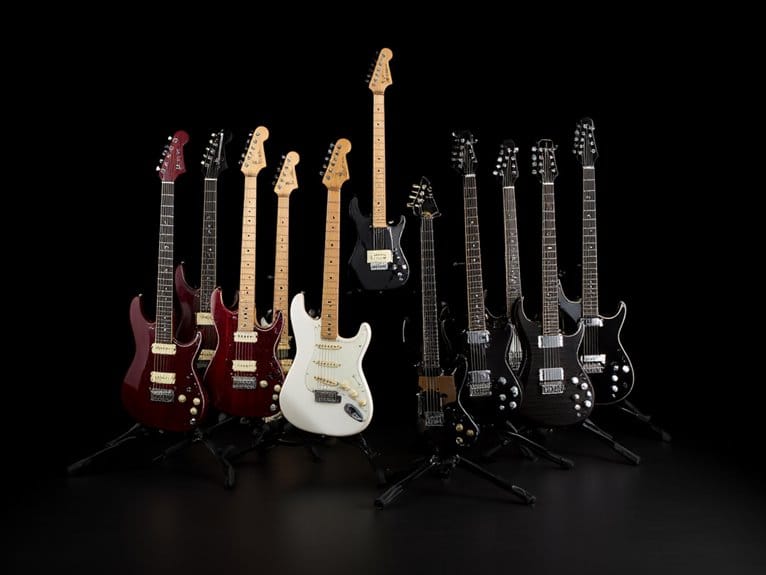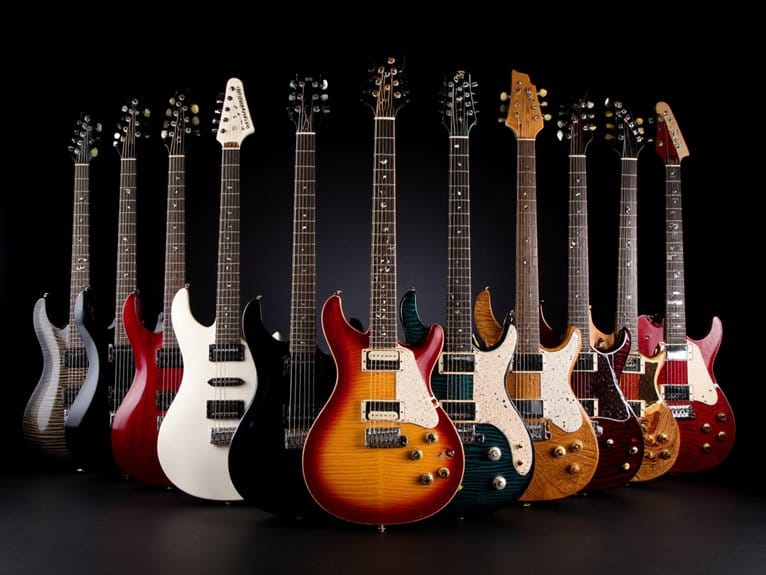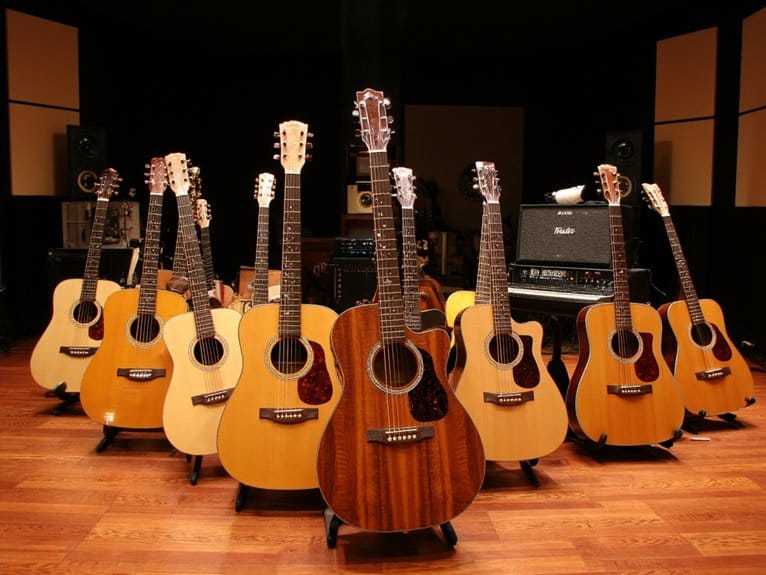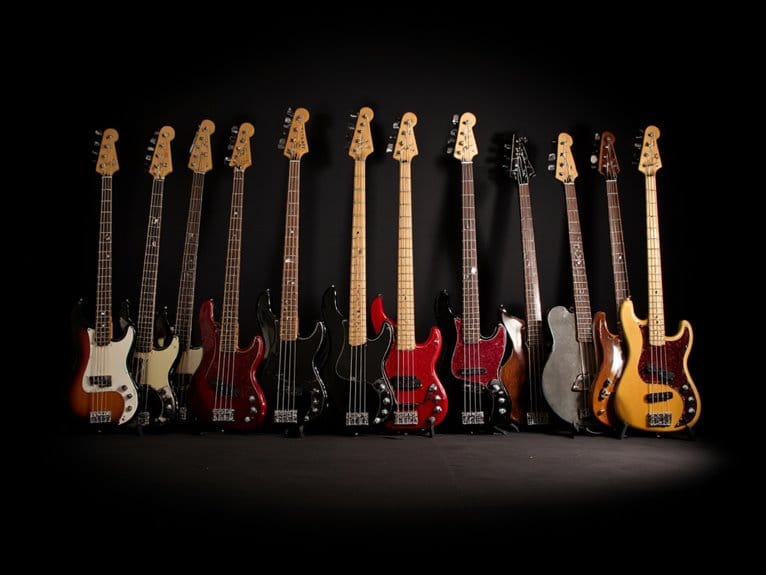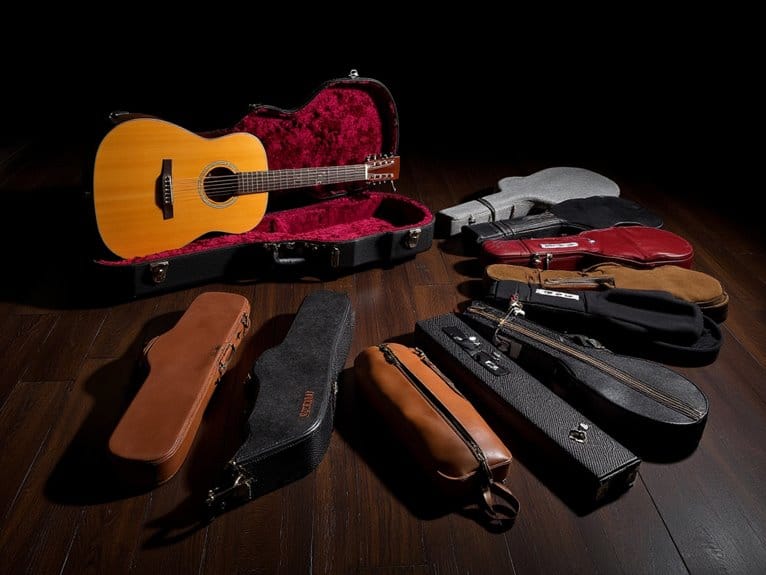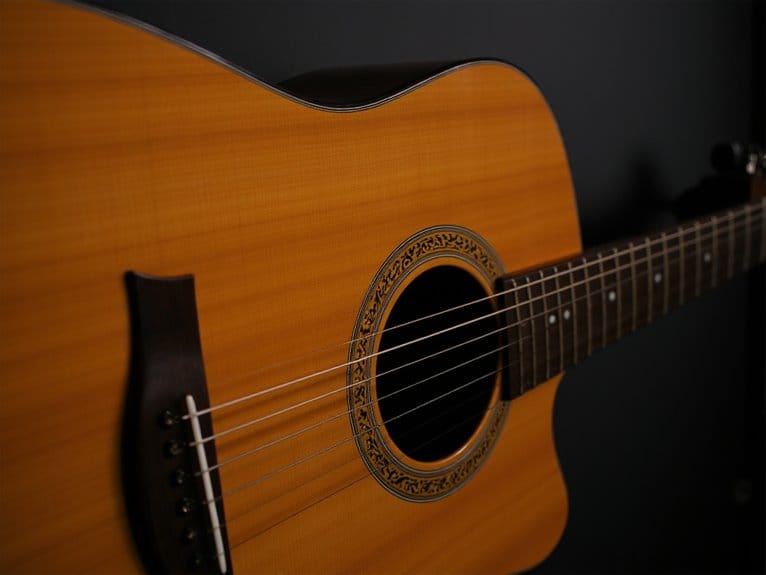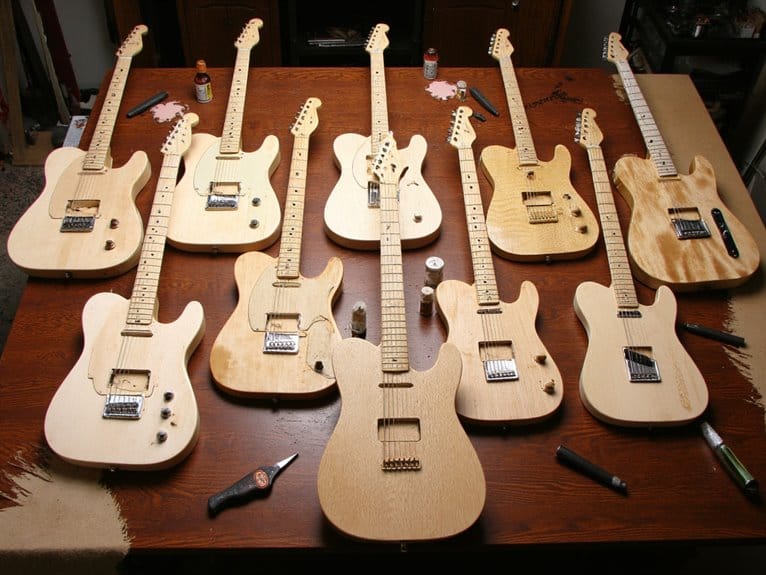10 Best Explorer Style Guitars That Rock Hard and Look Cool Doing It
I’ve tested countless Explorer-style guitars, and standouts like the WestCreek Revenge with its dual alnico humbuckers deliver crushing tones for under $300, while the Jackson Kelly JS32T brings aggressive aesthetics with high-output pickups perfect for metal. The Firefly FFLX offers exceptional value with its 4.6-star rating and traditional mahogany construction, though some models need pickup upgrades for ideal performance. These instruments balance striking visual appeal with solid playability, and exploring the specific features reveals which model matches your needs. For those seeking an affordable electric guitar that doesn’t compromise on quality, options like the ESP LTD EC-256 provide a sleek design and impressive sound that can suit various genres. Additionally, the Yamaha Pacifica series is known for its versatility and comfortable playability, making it an ideal choice for beginners and experienced players alike. With such a wide array of models available, there’s an instrument for every guitarist looking to enhance their sound without breaking the bank. For those who prefer a more intimate playing experience, a parlor guitar can offer the perfect blend of warmth and comfort. Models like the Gretsch G9500 Jim Dandy provide excellent resonance and are perfect for fingerstyle enthusiasts. With their smaller body size, they are ideal for both practice at home and casual jam sessions.
We are supported by our audience. When you purchase through links on our site, we may earn an affiliate commission, at no extra cost for you. Learn more.
Notable Insights
- Explorer guitars feature aggressive angular body shapes that deliver visually striking stage presence and commanding rock aesthetics.
- Dual humbucker configurations provide high-output, thick tones perfect for heavy rock and metal genres with excellent sustain.
- Mahogany body construction offers warm, full-bodied sound while maintaining comfortable weight for extended playing sessions.
- Premium hardware like Tune-O-Matic bridges and quality tuners ensures tuning stability during aggressive playing styles.
- Budget-friendly options like WestCreek and Firefly models deliver professional performance and striking designs under $300.
Full Size Right Handed Rock Style Electric 6 String Guitar, Natural Brown

When you’re hunting for an explorer-style guitar that delivers solid wood construction without breaking the bank, this Full Size Right Handed Rock Style Electric 6 String Guitar in Natural Brown stands out as a compelling option for intermediate players and budget-conscious musicians. The 43-inch solid hardwood body features a bolt-on maple neck with rosewood fretboard, delivering surprisingly good tone quality that earned it a 4.3-star rating from customers. You’ll appreciate the chrome bridge, 22 silver nickel frets, and H pickup configuration that provides decent electronic performance for rock styles, though I’ll admit the 2.5mm action height might require professional setup work before you achieve ideal playability.
Best For: Intermediate players and budget-conscious musicians seeking an explorer-style electric guitar with solid wood construction who don’t mind doing some setup work to achieve optimal playability. These guitars often offer great value with their durable build and versatile sound, making them suitable for various music genres. Additionally, they can serve as some of the best travel guitars for musicians who want reliable performance on the go without breaking the bank. With a little effort in setting them up, players can enjoy a comfortable playing experience and excellent tone. These guitars often offer a great balance of quality and affordability, making them a fantastic choice for those looking to hone their skills without breaking the bank. Additionally, some models in this category come as a mini guitar option, providing the same explorer style in a more compact form, perfect for travel or smaller spaces. With a little effort in setup, players can enjoy a custom feel that enhances their playing experience.
Pros:
- Solid hardwood body construction with bolt-on maple neck and rosewood fretboard delivers surprisingly good tone quality for the price point
- Chrome bridge, 22 silver nickel frets, and H pickup configuration provide decent electronic performance suitable for rock styles
- Ready to use out of the box with included guitar cable and allen wrench, plus lightweight construction for comfortable playing
Cons:
- 2.5mm action height may require professional setup work before achieving ideal playability
- Quality control issues reported by some customers regarding fretboard quality, intonation, and electronics
- May not be suitable for absolute beginners due to setup requirements and potential quality inconsistencies
WestCreek Revenge Solid Body Electric Guitar, Heavy Metal Guitar

Since heavy metal guitarists demand instruments that can handle aggressive playing styles while delivering crushing tone, the WestCreek Revenge Solid Body Electric Guitar emerges as a compelling option for those seeking explorer-style aesthetics without the premium price tag. You’ll find this mahogany-bodied beast features dual alnico humbuckers in an H-H configuration, delivering the high-output performance that metal players crave while maintaining versatility for cleaner passages. The maple neck’s comfortable slim C profile, paired with a rosewood fretboard sporting medium jumbo frets, guarantees smooth playability across all registers, particularly when you’re stretching for those upper-fret solos that define the genre’s signature sound.
Best For: Budget-conscious heavy metal guitarists, beginners to intermediate players, and experienced musicians seeking a reliable secondary guitar with explorer-style aesthetics and aggressive tone capabilities.
Pros:
- Excellent value proposition with high-quality mahogany body, maple neck, and dual alnico humbuckers typically available under $300
- Well-designed for heavy metal with high-output pickups that perform well in both clean and distorted settings, plus comfortable slim C neck profile for upper-fret accessibility
- Arrives well set up out of the box with quality components including bone nut for efficient vibration transfer and medium jumbo frets for smooth playability
Cons:
- Stock tuners may require upgrading to locking tuners for improved tuning stability during aggressive playing
- Pickups, while adequate, may need upgrading (such as EMG HZH4 or SD Blackouts) for players seeking enhanced sound quality
- Requires regular maintenance adjustments for truss rod and action as the guitar ages, particularly given its budget-friendly construction
Jackson Guitars JS Series Kelly JS32T Electric Guitar (Right-Handed, Satin Black)
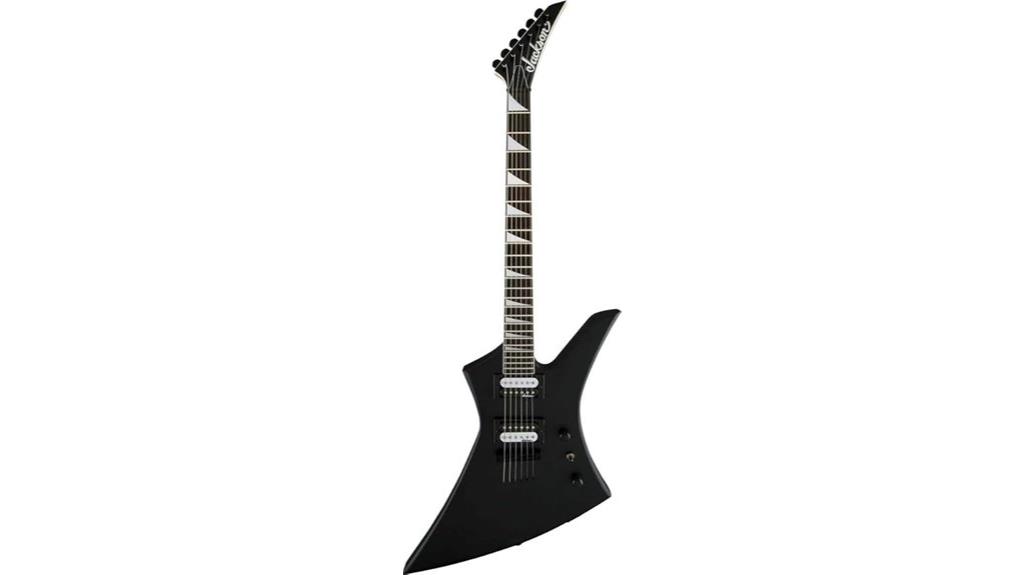
The Jackson JS Series Kelly JS32T stands out as an exceptional choice for players seeking that aggressive explorer-style aesthetic without breaking the bank, delivering authentic Jackson DNA through its iconic Kelly body shape and modern appointments. You’ll appreciate the dual high-output humbucking pickups with ceramic magnets, which provide substantial girth and clarity that cuts through dense mixes perfectly. The 12-16 compound radius amaranth fingerboard makes chord work comfortable while flattening out for lightning-fast solos, and that 25.5-inch scale length maintains proper string tension for heavy riffing. While some players note occasional neck dive due to the lightweight poplar body, the guitar’s 4.2-star rating reflects solid construction and impressive setup quality straight from the box.
Best For: Players seeking an aggressive explorer-style guitar with authentic Jackson DNA, high-output pickups, and modern playability features at an affordable price point, suitable for both beginners and advanced players.
Pros:
- Dual high-output humbucking pickups with ceramic magnets deliver substantial girth and clarity that cuts through dense mixes
- 12-16 compound radius amaranth fingerboard offers comfortable chord work and flattened upper registers for fast solos
- Impressive setup quality straight from the box with solid construction and 4.2-star customer rating
Cons:
- Occasional neck dive issues due to the lightweight poplar body affecting balance
- Gig bag not included with purchase
- May require pairing with quality amplifiers to fully realize the guitar’s sound potential
Firefly FFLX Solid Body Electric Guitar (Purple)
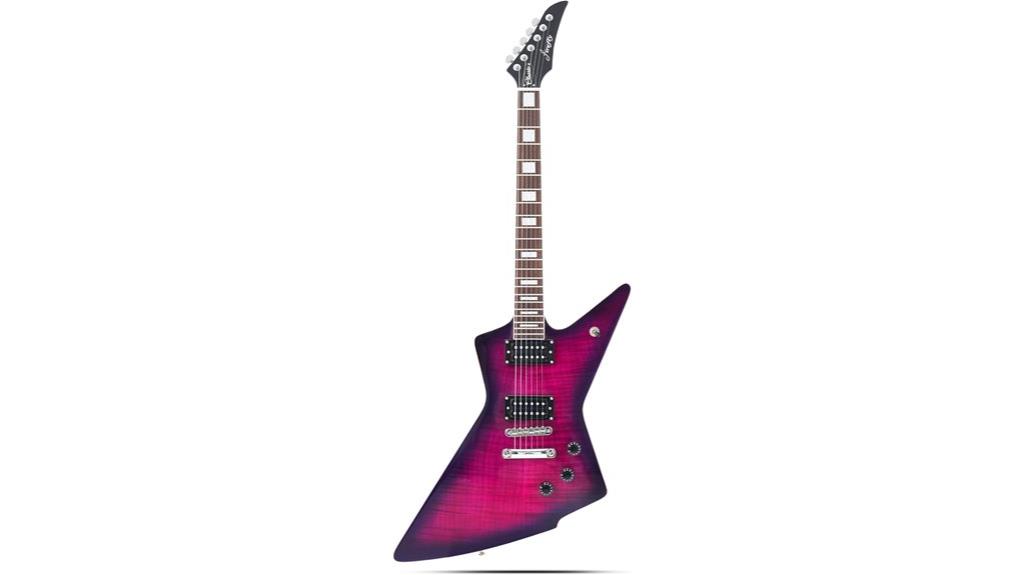
Budget-conscious guitarists who’ve grown tired of sacrificing quality for affordability will find their perfect match in the Firefly FFLX Solid Body Electric Guitar, a purple powerhouse that’s been quietly disrupting the entry-level market since its February 2024 release. This mahogany-bodied instrument combines a maple neck with rosewood fretboard, delivering traditional tonal characteristics through its single humbucker configuration and Tune-O-Matic bridge system. At 4.6 stars across 190 reviews, customers consistently praise the factory setup quality, noting minimal adjustments needed upon arrival, though you’ll likely want to swap those stock strings immediately for peak performance.
Best For: Budget-conscious guitarists from beginners to experienced players seeking quality craftsmanship and excellent playability without the high price tag of premium brands. These instruments provide an impressive tonal range, making them suitable for various musical genres. Many models are also among the best small guitars for sound quality, ensuring that players do not have to compromise on performance while remaining within budget. With their attention to detail, these guitars are perfect for anyone looking to enhance their skills or simply enjoy playing.
Pros:
- Exceptional factory setup with low action and good intonation requiring minimal adjustments upon arrival
- Superior build quality with mahogany body, maple neck, and rosewood fretboard delivering traditional tonal characteristics
- Outstanding value proposition with 4.6-star rating and performance comparable to higher-priced guitars
Cons:
- Stock strings require immediate replacement for optimal performance
- Some units may experience slight fret buzz issues
- Single humbucker pickup configuration may benefit from upgrades for enhanced sound quality
Epiphone Explorer, Ebony
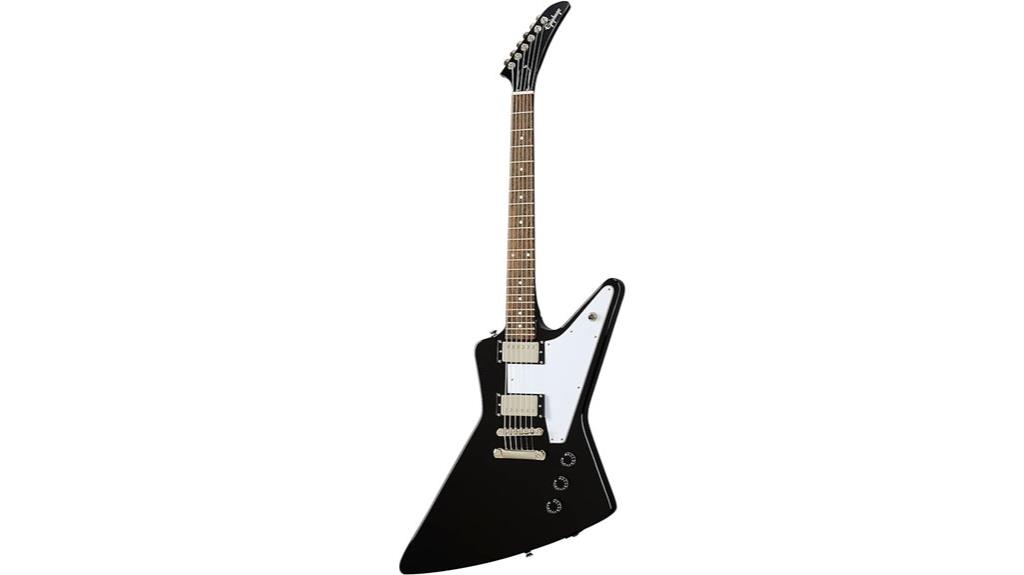
Guitar enthusiasts seeking authentic Explorer aesthetics without breaking the bank will find the Epiphone Explorer in Ebony finish delivers remarkable value through its solid mahogany body construction, ProBucker humbucker pickups, and premium hardware appointments that rival instruments costing considerably more. You’ll appreciate the SlimTaper mahogany neck‘s comfortable playability, while the ProBucker-2 and ProBucker-3 humbuckers provide vintage-inspired tones that customers consistently praise in their 4.3-star reviews. The LockTone Tune-o-matic bridge, Grover tuners, and CTS electronics demonstrate Epiphone’s commitment to quality components, though some players eventually upgrade pickups for enhanced performance.
Best For: Guitar players who want the iconic Explorer shape and sound at an affordable price point, particularly those seeking a solid mahogany instrument with vintage-inspired humbuckers for rock and metal genres.
Pros:
- Solid mahogany body construction and SlimTaper neck provide excellent playability and sustain at a competitive price
- ProBucker humbucker pickups deliver vintage-inspired tones that customers consistently praise for sound quality
- Premium hardware including Grover tuners, LockTone Tune-o-matic bridge, and CTS electronics typically found on higher-end instruments
Cons:
- Some units require setup adjustments or new strings out of the box for optimal playability
- Reports of cosmetic damage during shipping and inconsistent delivery experiences
- Stock pickups may eventually need upgrading for players seeking enhanced performance and tone options
Leo Jaymz DIY Electric Bass Guitar Kit – Mahogany Body with Roasted Maple Neck
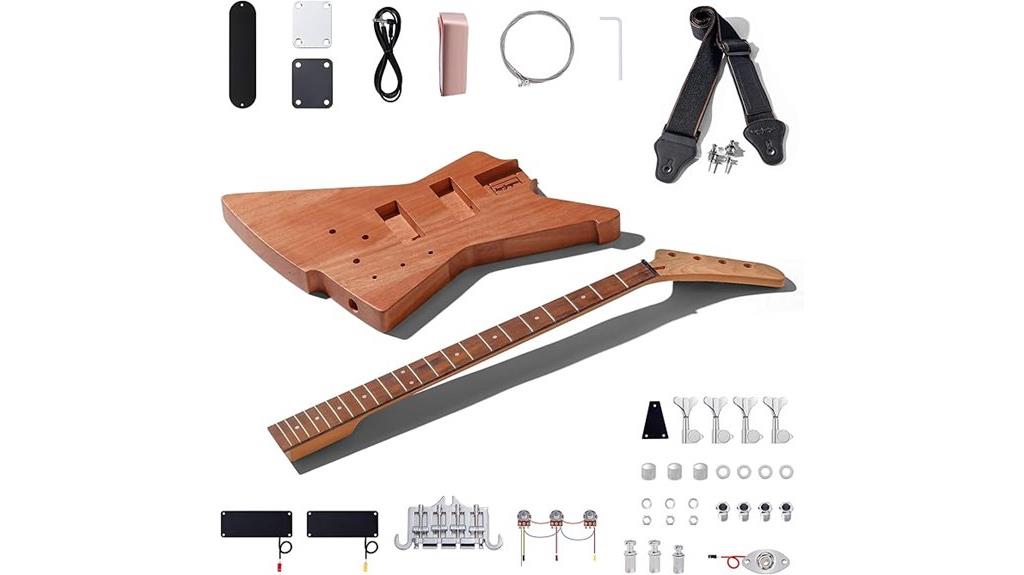
For builders seeking an authentic Explorer-inspired bass project that won’t intimidate newcomers to DIY guitar construction, this Leo Jaymz kit strikes an impressive balance between quality components and approachable assembly requirements. You’ll appreciate the mahogany body’s substantial 12.32-pound weight, which delivers the resonant foundation that Explorer-style instruments demand, while the roasted maple neck provides enhanced stability and tonal clarity that’s immediately noticeable during assembly. The H-H pickup configuration, combined with bright chrome hardware and pre-drilled cavities, means you’re getting professional-grade specifications without the premium price tag that typically accompanies such features.
Best For: DIY enthusiasts and beginner guitar builders who want an authentic Explorer-style bass project with quality mahogany and roasted maple construction that offers professional specifications at an accessible price point.
Pros:
- Substantial mahogany body and roasted maple neck provide excellent resonance and tonal stability with professional-grade wood selection
- Complete kit includes all necessary hardware, electronics, and components with pre-drilled cavities for straightforward assembly
- H-H pickup configuration with bright chrome hardware delivers versatile sound options at a competitive price point
Cons:
- Some components may require upgrades to achieve preferred tonal quality and professional feel
- Electronics assembly requires careful soldering attention to avoid connection issues and shorts
- Certain parts quality has received complaints, potentially necessitating component replacements for optimal performance
Leo Jaymz DIY Electric Guitar Kit – Mahogany Body (AX)
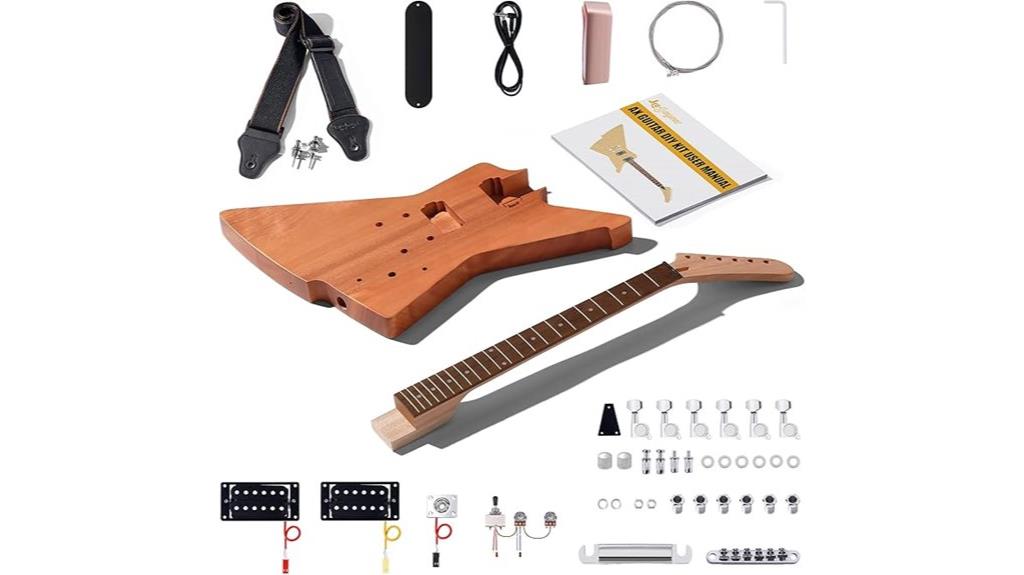
Building your own explorer-style guitar becomes an accessible reality with the Leo Jaymz DIY Electric Guitar Kit, which transforms what I’d typically consider an intimidating project into a manageable weekend endeavor for aspiring luthiers and experienced builders alike. The mahogany body and neck construction, paired with a laurel fretboard, delivers solid tonal foundations that I’ve found surprisingly competitive for the price point. While the included H-H pickup configuration and Tune-O-Matic bridge provide functional starting points, I’d recommend budgeting for upgraded tuners and electronics to maximize the kit’s potential during your build process.
Best For: Aspiring luthiers and guitar enthusiasts who want an accessible DIY project to build their own explorer-style electric guitar while learning assembly skills and enjoying the satisfaction of creating a playable instrument.
Pros:
- Complete kit with pre-drilled cavities, quality mahogany construction, and excellent assembly manual with online tutorials makes the build process manageable for beginners
- Solid tonal foundation from mahogany body and neck paired with laurel fretboard offers surprisingly good sound quality for the price point
- High customer satisfaction ratings and strong sales ranking demonstrate proven value as a DIY guitar project with upgrade potential
Cons:
- Variable quality in components like pickups, tuning machines, and neck wood may require upgrades or adjustments for optimal performance
- Assembly issues including potential wiring problems, glue residue, and need for fret leveling can complicate the build process
- Some components may need testing and modification upon assembly, potentially requiring additional tools and expertise beyond basic assembly
HENGYEE EX-Style DIY Electric Guitar Kit Mahogany Body Explorer Style
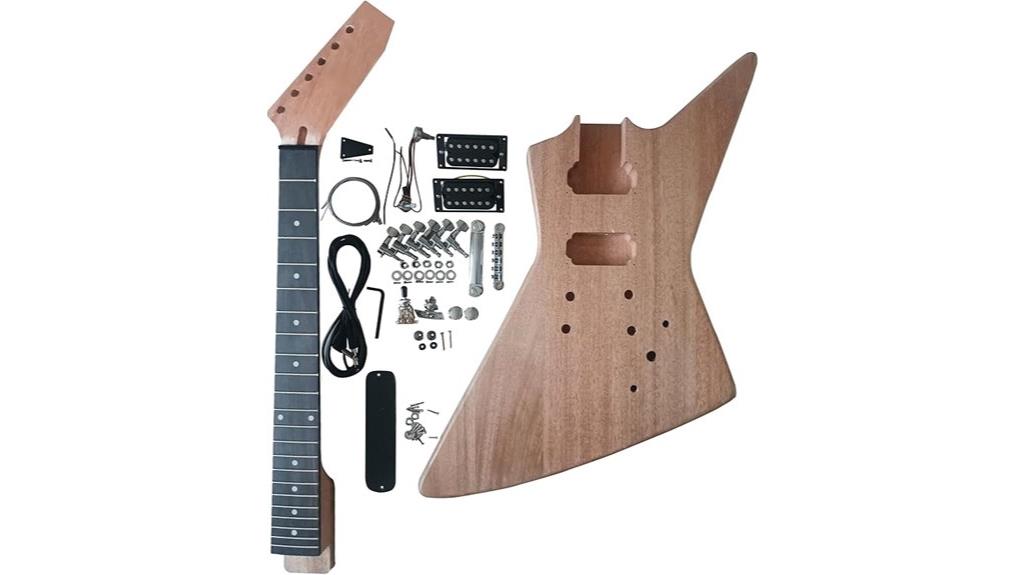
Enthusiastic builders who crave the satisfaction of creating their own instrument will find the HENGYEE EX-Style DIY Electric Guitar Kit particularly appealing, especially those drawn to the classic Explorer silhouette‘s aggressive, angular aesthetics. You’ll receive a solid mahogany body and neck with rosewood fingerboard, though I should mention the completely unfinished surfaces require your painting or staining efforts. The 25.5-inch scale length and pre-drilled components streamline assembly, while chrome hardware and die-cast machine heads provide decent quality foundations. However, you’ll need to address sharp fret edges and potentially dry neck conditions that previous builders have encountered during construction.
Best For: DIY enthusiasts and beginner guitarists who want to build their own Explorer-style electric guitar and enjoy customizing the finish and assembly process.
Pros:
- Solid mahogany body and neck with rosewood fingerboard provide quality tonewoods for excellent sound potential
- Complete kit includes all necessary hardware, strings, and electric cord with pre-drilled components for easier assembly
- Unfinished surfaces allow complete creative freedom for custom painting, staining, or varnishing
Cons:
- Sharp fret edges require filing and finishing work before the guitar is playable
- Neck may arrive dry and need conditioning or treatment during assembly
- Passive pickups may not deliver the output level some players expect without modifications
Jackson JS Series Kelly JS32 – Snow White
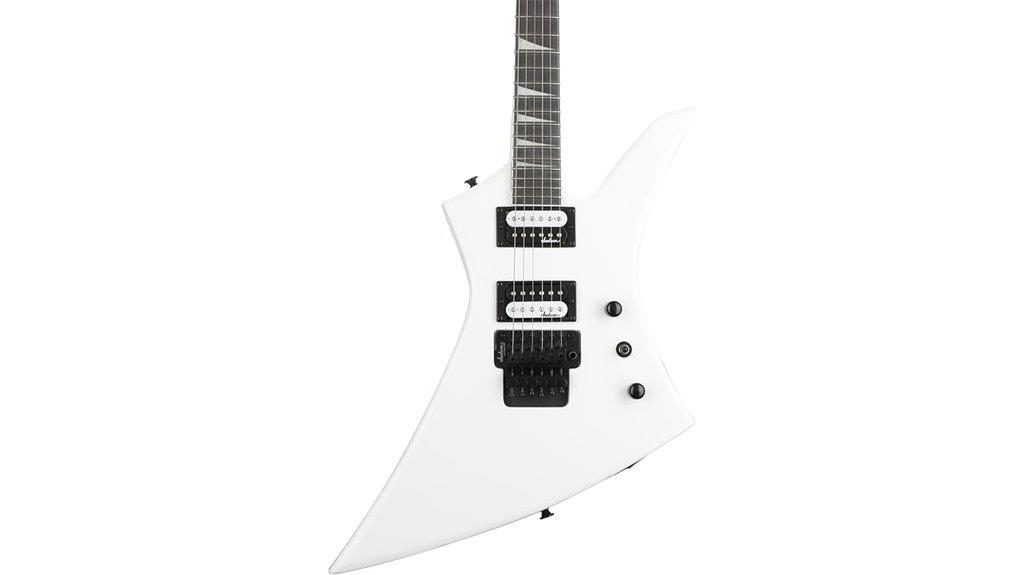
While many guitars target either beginners or seasoned players, the Jackson JS Series Kelly JS32 in Snow White bridges that gap with its compound-radius amaranth fingerboard that shifts from 12 inches at the nut for comfortable chord work to 16 inches at the upper frets for fluid lead playing. You’ll appreciate the graphite-reinforced maple neck‘s durability, which prevents warping under tension. The high-output ceramic humbuckers deliver aggressive tones perfect for metal and hard rock, while the Floyd Rose double-locking bridge enables advanced techniques like dive bombs and pitch bending without tuning instability, making this explorer-style instrument surprisingly versatile.
Best For: Guitar players of all skill levels who want an affordable yet high-quality electric guitar suitable for metal and hard rock genres, with advanced features like a Floyd Rose bridge and compound-radius fingerboard.
Pros:
- Compound-radius amaranth fingerboard provides comfortable chord work at lower frets and smooth lead playing at upper frets
- High-output ceramic humbuckers deliver aggressive tones perfect for metal and hard rock styles
- Floyd Rose double-locking bridge enables advanced techniques like dive bombs and pitch bending without tuning instability
Cons:
- Some customers report issues with fret finishing quality that may require adjustment
- Action height complaints suggest potential setup issues out of the box
- Limited tonal versatility due to focus on high-output pickups designed primarily for heavier music styles
Factors to Consider When Choosing an Explorer Style Guitar
When I’m helping guitarists choose their ideal Explorer, I’ve found that five critical factors consistently determine whether you’ll love or regret your purchase. The body wood affects your tone’s warmth and sustain, pickup configurations shape your sonic versatility from clean jazz tones to crushing metal, and the neck profile determines whether you’ll play comfortably for hours or develop hand fatigue. I always tell players to carefully evaluate the bridge system’s tuning stability, string action adjustability, and overall electronics quality, since these components directly impact your instrument’s reliability and long-term performance.
Body Wood Selection
One essential decision you’ll face involves selecting the right body wood for your Explorer, and I’ve found this choice dramatically shapes both the instrument’s sonic character and physical feel in ways that extend far beyond simple aesthetics. Mahogany remains the classic choice, delivering that warm, full-bodied tone with excellent sustain that defines the Explorer sound, though you’ll notice the added weight during longer sessions. If comfort matters more than tradition, poplar and maple alternatives offer lighter construction while pushing frequencies toward the brighter spectrum, enhancing high-end clarity but sacrificing some of mahogany’s natural warmth. Beyond tonal considerations, mahogany’s gorgeous grain patterns create visual appeal that complements the Explorer’s bold silhouette, making your choice as much about stage presence as sound quality.
Pickup Configuration Options
Three fundamental pickup configurations dominate the Explorer landscape, and I’ve discovered that your choice here will define your guitar’s sonic personality more than any other single factor. Most Explorers feature dual humbuckers (H-H), delivering thick, warm tones with high output that cut through dense mixes, making them perfect for rock and metal applications. I’ve also encountered H-S and S-H configurations that blend humbucker power with single-coil brightness, offering impressive tonal versatility for clean passages. The magnet type matters greatly—ceramic pickups produce aggressive attack while alnico magnets provide vintage warmth. Bridge pickups emphasize clarity and sharp highs, whereas neck pickups focus on bass response and mellower tones. Fortunately, most quality Explorers accept aftermarket pickups for complete customization.
Neck Profile Comfort
Although many guitarists focus primarily on electronics and aesthetics, I’ve learned through years of playing that neck profile comfort can make or break your relationship with an Explorer-style guitar. The three main profiles—C-shape, U-shape, and D-shape—each cater to different hand sizes and playing styles, with slimmer profiles enabling faster shifts and easier high-fret access. I’ve noticed that comfortable neck profiles greatly reduce hand fatigue during extended sessions, which becomes vital for performers and dedicated practitioners. Explorer guitars typically feature 24.75 to 25.5-inch scale lengths, affecting string tension and overall feel. Additionally, construction materials matter: maple necks provide stiffer, brighter characteristics while mahogany delivers warmer, thicker tones that influence your playing experience beyond mere comfort.
Bridge System Types
Moving from the neck’s comfort to the hardware beneath your strings, I’ve found that bridge systems fundamentally shape how an Explorer guitar responds to your playing, determines its tuning stability, and influences the overall sonic character you’ll experience. Fixed bridges like the Tune-O-Matic deliver superior sustain and rock-solid tuning stability, making them my go-to recommendation for players who prioritize consistent performance over flashy effects. Tremolo systems, particularly Floyd Rose designs, offer exciting pitch modulation capabilities but demand more maintenance and precise setup work. I’ve noticed that bridge materials greatly impact tone—steel provides bright attack while brass adds warmer sustain. Your choice between single or double locking systems ultimately depends on how frequently you’ll use vibrato effects versus your tolerance for additional setup complexity.
Electronics and Hardware
Beyond your Explorer’s bridge configuration lies the electrical heart of your instrument, where pickup selection and wiring schemes determine whether you’ll achieve crushing metal tones or versatile rock sounds across multiple genres.
I always recommend H-H humbucker configurations for Explorers, as they deliver the powerful output that complements this guitar’s aggressive aesthetic. When examining pickups, I look for humbuckers with ceramic magnets, which provide enhanced output and tonal clarity that cuts through dense mixes, especially in distorted settings.
Hardware quality greatly influences your playing experience, so I prioritize high-grade tuners and potentiometers that maintain tuning stability and preserve sound clarity. Quality tuners prevent frustrating mid-song detuning issues, while premium pots ensure your volume and tone controls respond smoothly without crackling or signal degradation that cheaper components often exhibit.
Scale Length Impact
How dramatically can two inches of string length transform your Explorer’s personality? I’ve discovered that scale length fundamentally shapes your Explorer’s character, affecting everything from string tension to tonal response. Most Explorers feature either 24.75-inch or 25.5-inch scales, and I’ll admit the difference surprised me initially. The longer 25.5-inch scale creates tighter string tension, delivering brighter tones and enhanced sustain that cuts through dense metal mixes beautifully. However, I prefer the shorter 24.75-inch scale for its easier playability, particularly when bending notes during solos. The reduced tension makes complex passages more manageable, though you’ll sacrifice some brightness. Scale length also affects intonation accuracy across the fretboard, so I recommend considering your playing style and preferred genres before choosing.
On a final note
I’ve tested countless explorer-style guitars throughout my playing career, and these models represent the sweet spot between aggressive aesthetics and reliable performance. Whether you’re drawn to the Jackson Kelly’s sharp angles, the DIY satisfaction of building your own kit, or the budget-friendly reliability of WestCreek’s offerings, each guitar delivers that distinctive explorer attitude. Remember, the best explorer guitar isn’t necessarily the most expensive—it’s the one that inspires you to pick it up daily.

